You can read excellent summaries of the book by Ugo Bardi, and Joseph Tainter himself.
Introduction
Ruins and relics of long dead civilizations, now overtaken by vines of verdant chaos, or buried under the shifting sands of time, hold a certain morbid fascination for us - these once great, hubristic and monumental societies that flourished and then collapsed, leaving only ruins and legends in their wake. We cannot help entertaining thoughts about the sustainability of own, global, industrial civilization; the "possibility that a civilization should die doubles our own mortality".
What is collapse? Tainter starts off by defining collapse - when an empire, chiefdom or tribe experiences a "significant loss of an established level of socio-political complexity", manifesting itself in decreases in vertical stratification, occupational specialization, regimentation, centralization, information and trade flows, literacy, artistic achievement, territorial extent and investment in the "epiphenomena of civilization" (palaces, granaries, temples, etc). He summarizes a large number of historic collapses - Harappa, the Western Chou, Mesopotamia, Egypt, Mycenaean Greece, the Roman Empire and different American cultures.
Civilization and Collapse
Historical cases of collapse. In many cases a formerly highly organized, regimented and standardized civilization devolved into a more chaotic, brutal and cruder one. As they experienced stresses, evidence grows of separatism, feudalism, barbarian invasions and civil war and famines. As in Rome during the Crisis of the Third Century or the Old Kingdom of Egypt after 2181BC, there were multiple rulers competing for power in any one year. Legitimizing symbols of the old order were destroyed, like the burned palaces in Mycenaean Greece and the toppled basalt monuments of the Olmecs and the deconstructed ruins of the Egyptian pyramids. Archaeologists discovered unburied corpses, hoarded jewelry and primitive huts in the cities of post-collapse Harappa; in many cases, grand buildings and monumental works such as the Pyramids are deconstructed to help build local, humbler dwellings to last out the approaching Dark Ages... For some collapses can be very long indeed. A thousand years separated the fall of the Western Roman Empire and the Renaissance. After its 11th C collapse, the population of Mesopotamia dropped to its lowest level in at least 5000 years and until modern times the areas outside Baghdad reverted to nomadism. The mother of all collapses is that of the Ik (used by Dmitry Orlov to represent the fifth, and last, stage of collapse) - in this hunter-gatherer society, at one point all familial and social relations broke down, subsistence was pursued individually and universally abandoned children coalesced into "age sets" for mutual protection.
After the Roman withdrawal, Britain descended into lawlessness as villas and cities were burned, looted and replaced by small fortified settlements; barter and self-sufficiency replaced money and trade networks. Public works, literacy, and internal and external security vanished; for in a "complex society that has collapsed...the overarching structure that provides support services to the population loses capability or disappears entirely" - the "world as seen from any locality perceptibly shrinks, and over the horizon lies the unknown".
Benefits of collapse? This is not, however, to say that after collapse the world shifts into a post-apocalyptic Mad Max-style Hobbesian war of all against all where the center doesn't hold, grass grows in a streets and bands of malnourished survivors scavenge amidst the rusted ruins of former grandeur. Contemporary elites incapable of primary food production (as well as historians) see the loss of peace, great literature and technology in a tragic light; yet collapse is at base an economizing process carried through by rational individuals for whom this outcome is objectively preferable. There is evidence that in many parts of the Roman Empire average nutrition actually improved, since the peasants were no longer burdened into forced savings to maintain the imperial superstructure of magnates, bureaucrats and soldiers.
What are complex societies? Complex societies range from kinship-based bands and chiefdoms dominated by populist "Big Men" to territorially-defined nations ruled over by a depersonalized government drafted from the ranks of entrenched elites with monopolies on violence, taxation and legislation and needing constant ideological legitimization and coercion to sustain themselves. The more highly complex societies (based on "organic solidarity", vertical stratification and horizontal specialization) are "nearly decomposable systems" made from simpler building blocks, which decompose into their constituent forms after a collapse.
How do complex societies evolve? There exist two major schools of thought on this issue, the "Marxist" / "conflict" and the "integrationist". In The Family, Private Property and the State, Engels wrote that differential acquisition of wealth led to hereditary nobility, monarchy, slavery and imperialist wars - to maintain the privileged position of a ruling class based on exploitation and coercion of the masses (and contradictions in social systems between antagonistic classes drove history). However, there is a contradiction. Marxists say surpluses are needed for state formation, but since material conditions are culturally mediated, why can't they be concocted whenever one pleases? Why did humanity spend more than 99% of its history in primitive bands?
The integrationists believe that states stem from the needs of society based on a shared consensus, not the ambitions of elites and coercive dominance. This is usually in response to a problem that could be better solved with managerial hierarchies - for instance, a hydraulic despotism can concentrate powers of information processing and labor mobilizations to build and maintain irrigation systems, thus solving the problem of overpopulation in a limited and stressed environment - at least for a time. In this view, elites get compensated for fulfilling their beneficial roles, though Marxists can still make the valid argument that historically their rewards tended to surpass their real contributions because of coercion (soldiers, control over food, etc) and legitimizing propaganda and ideologies.
In conclusion, a synthesis is possible between the two theories. Institutions form from unequal access to resources AND create benefits for average citizens. Integrationism accounts better for distribution of necessities of life; conflict theory for surpluses. Pure self-aggrandizement can't account for state development, but helps understand their subsequent history. Complex societies are fundamentally problem-solving organizations, operating through "conflict theory" to resolve the problems stemming from differentiated economic success and through "integration theory" to secure the common wellbeing. When they grow in complexity, societies move from being small, internally homogenous, little undifferentiated bands and chiefdoms with ephemeral and unstable leaders, to large, heterogeneous, internally differentiated, class structured, controlled and unequal nations, requiring constant legitimization, reinforcement and coercion to sustain themselves. Collapse is rapid decline in established level of complexity along continuous variable, from one structurally stable level to another.
Problems with existing explanations for collapse. Tainter devotes a chapter to criticizing the most common explanations for collapse as of 1988:
- Depletion or cessation of vital resources;
- Establishment of new resource base;
- Insurmountable catastrophe;
- Insufficient response to circumstances;
- Other complex societies;
- Intruders;
- Class conflict, societal contradictions, elite mismanagement;
- Social dysfunction;
- Mystical factors;
- Chance concatenation of events;
- Economic factors.
Though suitably simple, apocalyptic and attractive catastrophes and barbarian intruders cannot explain the deeper why? of collapse. The whole point of complex societies is to marshal the surpluses necessary for overcoming such systematic shocks - when the system becomes too fragile, these can tip it over into collapse as happened with the Minoans after the eruption of Thera (it received "... irreparable blow, and from then onwards gradually declined and sank into decadence, losing its prosperity and power"). Rome brushed off the disastrous manpower losses of the Carthaginian Wars with east and even managed to withstand severe barbarian pressure during its Crisis of the Third Century; yet relatively weaker forces toppled the demoralized and anemic Western Roman Empire of the 4th C. Economic problems and elite mismanagement and cronyism are more a symptom of collapse than an explanation.
Explanation through mysticism is the oldest explanation, with Plato writing in Laws, "...since all created things must decay, even a social order...cannot last forever, but will decline". Writing his seminal Decline and Fall of the Roman Empire, Gibbons attributed the imperial predicament to relaxation of military discipline, Christianity, ignorance of dangers, bad emperors and the decline of martial spirit with prosperity. Major modern theorists included Danilevsky, Spengler and Toynbee. A lovely, demonstrative quotation from Decline of the West by Spengler is a good example of mystical thinking about collapse:
A Culture is born in the moment when a great soul awakens out of the proto- spirituality of ever-childish humanity, and detaches itself, a form from the formless, a bounded and mortal thing from the boundless and enduring. It blooms on the soil of an exactly-definable landscape, to which plant-wise it remains bound. It dies when this soul has actualized the full sum of its possibilities in the shape of peoples, languages, dogmas, arts, states, sciences, and reverts into the proto-soul. But its living existence, that sequence of great epochs which define and display the stages of fulfillment, is an inner passionate struggle to maintain the Idea against the powers of Chaos without and the unconscious muttering deep-down within...The aim once attained - the idea, the entire content of inner possibilities, fulfilled and made externally actual - the Culture suddenly hardens, it mortifies, its blood congeals, its force breaks down, and it becomes Civilization, the thing which we feel and understand in the words Egypticism, Byzantinism, Mandarinism. As such they may, like worn-out giant of the primeval forest, thrust their decaying branches towards the sky for hundreds or thousands of years, as we see in China, in India, in the Islamic world...At last, in the grey dawn of Civilization the fire in the Soul dies down. The dwindling powers rise to one more, half-successful, effort of creation, and produce the Classicism that is common to all dying Cultures. The soul thinks once again, and in Romanticism looks back piteously to its childhood; then finally, weary, reluctant, cold, it loses its desire to be, and, as in Imperial Rome, wishes itself out of the overlong daylight and back in the darkness of proto-mysticism in the womb of the mother in the grave.Unfortunately, mystical explanations relying on life and death biological growth analogies of life and death and vaguely defined concepts of "vigor" and "decadence" are scientifically unrigorous, albeit aesthetically attractive - as proved by the space Tainter himself feels compelled to devote to it!
Understanding collapse. As noted above, human societies are problem-solving organizations - the benefits of complexity are management of class struggle (conflict theory) or satisfaction of social needs (intlgration theory). Yet complexity needs energy to maintain itself - modern industrial civilization is more energy-intense than hunter-gatherer societies by many orders of magnitude. As civilization climbs up the ladder of complexity, ever more information networks, hierarchies and specialists have to be funded out of surpluses; thus, the per capita support costs for greater complexity continuously increase. However, investment in socio-political complexity as a problem-solving response often reaches a point of declining marginal returns (i.e. growth in costs overtakes growth in benefits, and collapse becomes increasingly likely when overall costs surpass gross benefits). Tainter backs up this theory of diminishing returns on complexity by analyzing several major features of complex societies.
Diminishing marginal returns to agriculture, mineral extraction. As the population grows, it is forced to intensify food production by transitioning from slash and burn agriculture to annual cropping or even multi-cropping (Boserup); furthermore, there is evidence the shift to farming from hunter-gathering was spurred on by rising population densities in the Fertile Crescent (Cohen). These early farmers were less healthy than wild men like Enkidu, yet they had huge advantages in numbers and organization. However, although overall food production rises the per unit labor output declines, eventually leading to a subsistence crisis and susceptibility to collapse-inducing systemic shocks; however, sometimes major jumps in population can result in transformation through discovery of a new energy subsidy as happened repeatedly in England around 1300, 1600 and the Industrial Revolution (Wilkinson). Since the largest, most accessible and concentrated ores and oil deposits are generally discovered and exploited first, marginal returns apply heavily to these enterprises (this is what EROEI is all about).
Diminishing marginal returns to information processing. Although the numbers of technical workers and R&D spending (see graph) mushroomed since the 19th C, US patents per capita peaked in 1850-1900. The amounts spent on medicine in relative terms, not to mention absolute, did nothing to avert slowing life expectancy growth (the easiest and most effective innovations are vaccinations, sanitation, basic hygiene and obstetrics - as long as the people are afflicted with drug addictions or other specific problems, concentrating on these is enough to raise life expectancy to 70 years. Returns on treating chronic conditions are much poorer, though there might be a revolutionary breakthrough that will reverse diminishing returns). Students are getting far longer and more specialized educations, which generally "yields decreased general benefits for greater costs", with specialization serving a narrower sector to general social cost. These observations are supported by Planck's Principle of Increasing Effort - "with every advance [in science] the difficulty of the task is increased" (i.e. you're now unlikely to make new discoveries by flying a kite in a thunderstorm). Furthermore, "Exponential growth in size and costliness of science, in fact, is necessary simply to maintain a constant rate of progress", and according to Rescher, "In natural science we are involved in a technological arms race: with every 'victory over nature' the difficulty of achieving the breakthroughs which lie ahead is increased".
Diminishing marginal returns to socio-political control. Parkinson makes observations on the tendency of bureaucracy to metastasize, e.g. noting how between 1935 and 1964 the number of officials in the British Colonial Service rose from 372 to 1661 even as the Empire disintegrated ("the bureaucracy is expanding to meet the needs of the expanding bureaucracy" - Civilization 4). But this cannot be specific to states because hierarchical specialization increased everywhere, including the cost-conscious private sector, because complex organizations need ever more administrators to manage ever greater requirements in information processing and integration of disparate parts requirements. This can result in vicious spirals and destructive loops. One example is Arms spiral → greater costs in unproductive military size, R&D on both sides → balance of power remains constant; another is taxation increases, regulation → avoidance, fewer returns, search for loopholes → more bureaucracy for finding loopholes, for coercion → more regulations, more taxes → budget deficits, inflation, delegitimization → more bread and circuses, coercion, etc → more taxes → collapse, etc - it's possible to build any number of these.
Diminishing marginal returns on economic productivity. It is well-known that advanced countries grow at a slow rate, since they already use all the more profitable technologies, while poorer countries can converge at a fast rate if the right conditions are in place (I wrote a lot on this on SO). Rich countries face declining marginal returns on investing in more economic growth, and need to spend more maintaining their existing level of complexity.
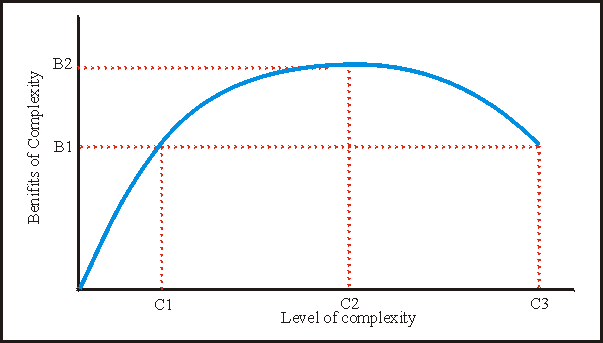
(My abstraction of collapse: Systematic increase in complexity → regulation of subsistence production → hierarchy, bureaucracy and agricultural facilities investment (irrigation) → agriculture for bureaucrats, more energy / minerals extraction → expanded military for protection → even more food and resources needed → more resources drained from support population → ever increasing demands on legitimization → if it fails, needs more coercion → more internal policing costs → delegitimization as taxes up, corruption up, infrastructure decays, no visible benefits → revenues down, budget deficits, inflation → decomposition becomes optimal option → stresses, fragility, drawdown of reserves → catastrophic event (invasion, climate shift, etc) → peasantry and regional magnates become apathetic to wellbeing of central powers → collapse to lower, more local and balanced, level of sociopolitical complexity).
The Collapse of the Roman Empire
At least in the West, the decline and fall of the Roman empire is the prime historical example of collapse. Though Tainter also takes an in-depth look at the Mayan and Chaco collapse, the Roman case is the most detailed.
During the early rise of the Republic, Roman expansion were self-financing. The accumulated surpluses of conquered peoples were assimilated, tributary flows established and for a time Roman citizens were relieved from taxation. In early agricultural societies, territorial aggrandizement was the only way to acquire the energy subsidies needed to increased complexity - but it was a poisoned chalice, for Rome assumed long-term obligations to administer, garrison and defend the new territories.
Already under Augustus (27BC-14AD) there appeared shortages of revenues, forcing him to introduce an unpopular 5% tax on inheritances and legacies to fund military pensions. The size of the empire was also capped by this period. The Roman Empire was centered around the Mediterranean because all the richest regions were concentrated there, since at the time bulk transport of goods (primarily food products) was only possible by sea. Further conquests like Britain and Dacia were net losses to the imperial accounts, while eastern lands were blocked by Parthia.
However, at the the benefits of empire firmly surpassed its costs. The Pax Romana was enforced by a standing, professional army that secured internal and external security. A competent civil service and extensive road and courier system encouraged trade and economic integration. Food storage and distribution was organized to prevent local famines (at least in regions near the coasts) and urban dwellers were treated to public works and treated with a public dole.
Yet those same above trends - increasing army size, burgeoning bureaucracy and welfarism - led to increasing stresses on the system that provided them. From the time of Nero, the state began to debase its currency by mixing silver with base metals, leading to the ancient equivalent of inflation.
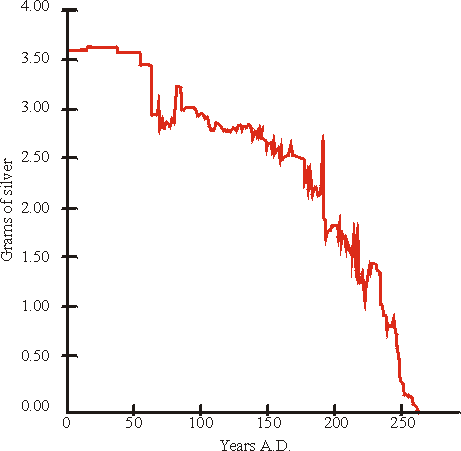
The chart shows grams of silver per denarius (the basic silver coin) from 0 to 237 A.D., and per 1/2 denarius from 238-269 A.D. (when the denarius was replaced by a larger coin tariffed at two denarii).
In general, "The expenses of government were steadily increasing out of proportion to any increase in receipts and the State was moving steadily in the direction of bankruptcy" (Matting). The Antonine Plague of 165-180AD depopulated the Roman Empire, fiscal difficulties multiplied and in 235-284 the Empire entered a period of unparalleled stresses known as the Crisis of the Third Century.
Emperors and pretenders ruled for months at a time before being sidelined or assassinated, usually after losing the critical support of the military. Trade networks declined precipitously as the countryside was afflicted by lawlessness, banditry and separatism, leading to rural depopulation. Peasants flocked to local notables and landowners for protection, resulting in the establishment of the self-sufficient manorial economy that would characterize medieval Europe - the Bagaudae in Gaul and Hispania were peasant insurgents reacting against these trends towards proto-feudalism. Barbarian incursions wracked border regions of the Empire and there was another plague in 150-170 AD.
Censuses and historical detail thin, as literacy and science declined during this period, to be replaced by an "increase in mysticism, and knowledge by revelation":
Literacy and mathematical training apparently declined during the third century... The major emphasis of what education remained was rhetoric, and that was not really relevant to the needs of the government. There was at the same time an increase in mysticism, and knowledge by revelation. The external threats brought increased propaganda about patriotism, ancient Roman values, and superiority over the barbarians.Inflation hurt state workers on fixed incomes (soldiers, bureaucrats, workers in military factories, etc), forcing the government to pay them in kind or bullion. Aurelian conscripted the craft associations to build walls around Rome. Costs, taxes and inflation continued to soar, to provide for continued growth in the army, bureaucracy, the dole and palaces; yet at the same time, the effectiveness and transparency of civil services declined and public works fell into disrepair.
Yet by then there were tentative signs of recovery. Aurelian reformed the coinage, reconquered lost provinces, repelled the barbarians and ordered the obligatory farming of land by drafting nearby villages and towns into agricultural work forces. Diocletian and Constantine made truly sweeping reforms that "levied all resources to one overarching goal: the survival of the state".
The army doubled in size from 300,000 under the Severans to more than 500,000. Diocletian built strategic networks of roads and fortresses along the frontiers; Constantine made the army more mobile, professional and increased the expensive cavalry component. The empire split into two and administrative units were made smaller to dissuade revolt, which required an even larger bureaucracy. Christianity was adopted for legitimization of the Emperor as God-sanctioned, with focus shifting from personality to symbols of power (diadem, mantle, scepter, orb). The new burdens resulted in more taxes and inflation, despite tax innovations and attempts to fix prices. The distinctions between private and public blurred as the State directed people into occupations (usually along generational lines) and levied their output.
Population remained down after the plagues - agricultural laborers were so rare landowners bribed vagabonds to enlist for military conscription. Height requirements were lowered and barbarians made up an ever larger share of the army. The demographic collapse continued unabated, despite attempts to reverse it like Constantine's program of assistance to orphans and poor children in 315AD.
Taxes, already high before the Dominate, doubled from 324 to 364; they were flat, unresponsive and regressive. The wealthy fled to the countryside, obtained exemptions on taxes and passed on their costs to peasants and the remaining urban middle classes. Since peasants had few reserves, if shocks like droughts, locusts or banditry ruined them they had to borrow, starve or sell down their possessions (land, children, etc). When they failed to repay, they were dispossessed and either coerced into serfdom or fled to the cities for relief, where the dole was still handed out. The result was depopulation o1f the countryside and impoverishment of the cities.
The burdens of complexity broke the Western Roman Empire. Different occupations fought for personnel, so military declined until barbarians were relied upon entirely to staff the army - Attila was defeated in Gaul in 451 by a federation of local Germanic kingdoms. Records indicate both rich and poor apathy, and even sympathy, to the barbarians (Balkan miners went over to the Visigoths en masse in 378).
According to RM Adams, "By the fifth century, men were ready to abandon civilization itself in order to escape the fearful load of taxes". In 476, after being denied payment or settlement in Italy, the Roman barbarian army mutinied, sacked Rome and deposed Romulus Augustus, the last Western Emperor.
For whereas "under the Principate the strategy had been to tax the future to pay for the present, the Dominate paid for the present by undermining the future's ability to pay taxes" - in the end this could have only ended in collapse.
Conclusions
Although the loss of art, literature and peace are seen as catastrophic, especially by elites incapable of primary food production and by later historians, it is always a rational, economizing process (see Romans aiding barbarians). This is because "at some point along the declining portion of a marginal return curve, a society reaches a state where the benefits available for a level of investment are no higher than those available for some lower level", thus opening a kind of potential gap. Population collapse usually preceded socio-political collapse (Roman depopulation began in the middle of the 2nd C).
Furthermore, "collapse occurs, and can only occur, in a power vacuum", for in a "competitive, or potentially competitive, peer polity situations the options to collapse to a lower level of complexity is an invasion to be dominated by some other member of the cluster...investment in organizational complexity must be maintained at a level comparable to one's competitors, even if marginal returns become unfavorable" - this accounted for how the competing Maya states took so long to collapse, and collapsed simultaneously when they did. For "the specific state is legitimized in the eyes of its citizens by the existence of other states which patently do function along comparable lines".
Implications for global industrial civilization. We are experiencing diminishing marginal returns in investment into agriculture, mineral extraction, energy efficiency, healthcare, education, political and industrial management, the military, some elements of technical design and further GDP growth. Furthermore, just as in the Roman Empire, some skeptics might argue that our credit-based, inflationary system taxes the future to pay for the present and our depletion of high-EROEI energy source and pollution emissions undermine the ability of the future to pay taxes.
We can already see "scanning" behavior for solutions - survivalism, sustainability, machine superintelligence - we would be wise to marshal resources and concentrate on intensification in this area, so as to increase the chances of achieving a technological transformation which will allow us to leap over the Olduvai Gorge. Success is not guaranteed, however, since R&D is itself subject to diminishing returns...
As Paul Valéry said, "...nothing can ever happen again without the whole world's taking a hand". Because of the lack of a power vacuum, any collapse will be global and densely spaced in time - hence the prevailing predictions about and fear over multiplying failed states in the decades ahead.
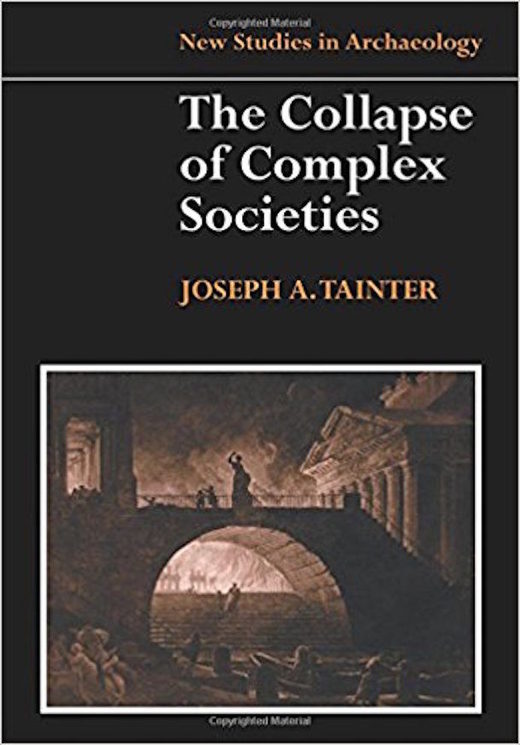
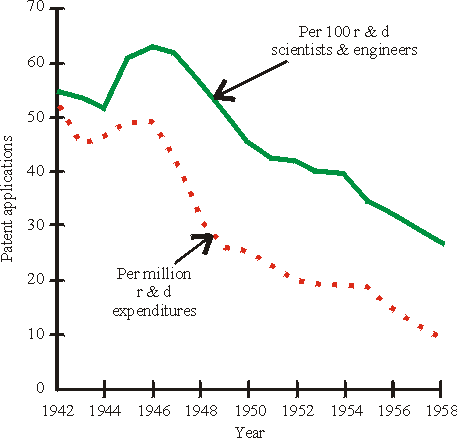
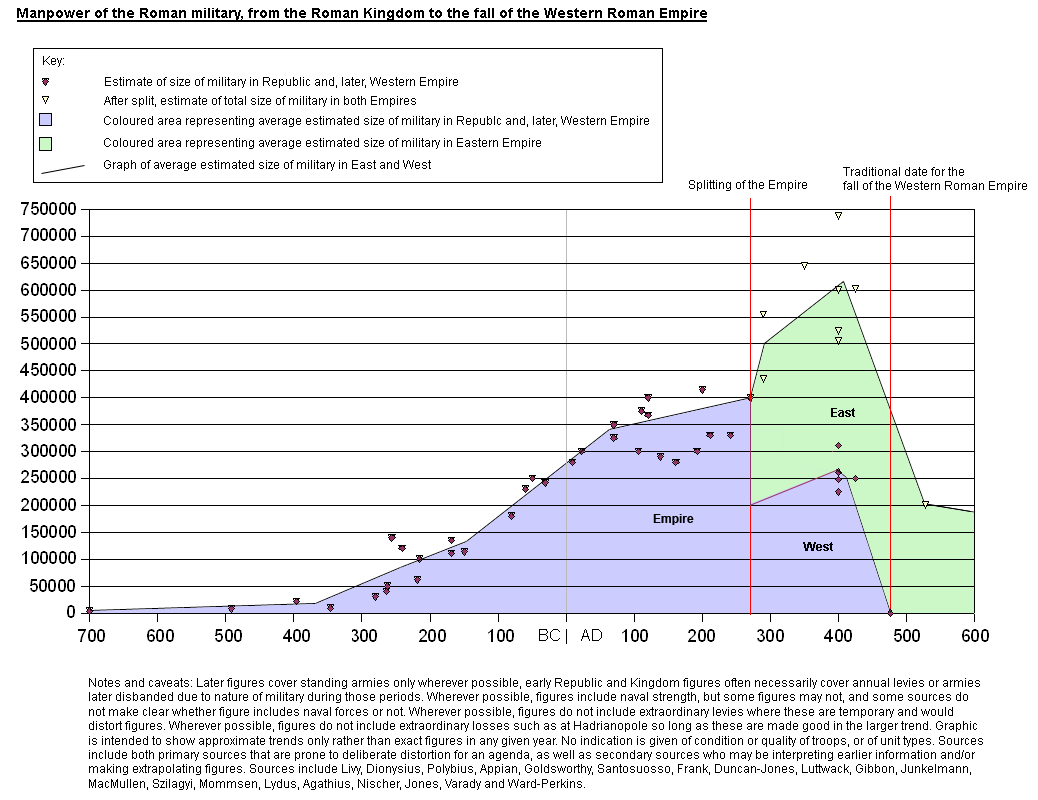



yeah right!!
... more like absurdly slow n stupid